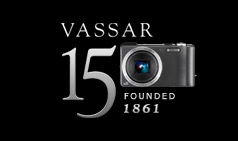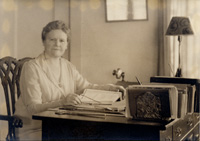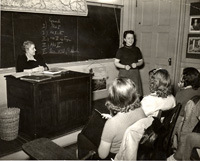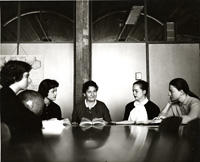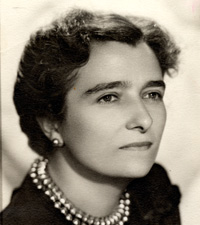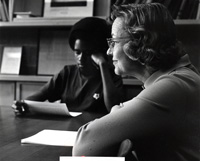The History of German Studies at Vassar College
by Stephen McCarthy '10 and Jeffrey Schneider, Associate Professor of German Studies
September 2011
Program Website
German has been offered at Vassar since the college opened its doors to 353 young women in 1865. Since those early days, however, the study of German has undergone enormous transitions. The works of Goethe and Schiller, for instance, no longer form the core of the German curriculum, but instead share space with feminist novels, anti-realist cinema, and first-person accounts of the Holocaust. Nevertheless, teachers from Vassar’s early history have bequeathed a rich pedagogical tradition that still infuses the ethos of the department. As a result, the study of German language, literature and culture has remained an important part of a liberal education—and an innovative and active area of the Vassar curriculum.
The First Decades
When Vassar was founded, the Department of Ancient and Modern Languages offered instruction in Latin and Ancient Greek as well as French and German—these latter two being “the only living tongues admitted to the curriculum,” as President Raymond explained in his report to the U.S. Commission of Education, Vassar College: A College for Women in Poughkeepsie (1873). While eight semesters of Latin were required, students were also expected to take four semesters of French, German, or Greek. The study of German began only in the students’ sophomore year, since Latin grammar was imagined to provide a foundation for the study of German.
During its early period, however, the language program faced some challenges when, for example, Professor William Knapp, the first Chair of Ancient and Modern Languages, left in 1867. Another teacher, Ada de Gréfin, lasted only four months before being replaced by Caecilie Kapp, who was hired to teach both German and French. Classes were also supplemented by extracurricular activities, such as a “German table” and “occasional German evenings” in which “dramatic and other recitations, songs, original essays, etc., afford the students valuable help in acquiring the fluency of utterance”—practices that continue to this very day. President Raymond also proudly noted that the College subscribed to several popular German-language periodicals and provided its students and faculty with “all the German classics and a copious collection of contemporary works,” many of which remain available to faculty and students today.
Early on, Vassar students distinguished themselves in the field of German. Upon his visit to Vassar in 1870 the president of Harvard, Charles William Eliot, noted that “that the boys at Harvard could not recite nearly as well in German, French or Latin, or even in mathematics, as the girls did [at Vassar].”
The Pre-War Years
The years leading up to the First World War were a heyday for German instruction at Vassar, as German was widely spoken throughout the U.S., and German universities were producing some of the most innovative scholarship in sociology, political science, philosophy, physics, chemistry, and medicine.
Vassar’s curriculum offered students a rigorous overview of German literature and culture. In the introductory “A course,” students read several books in their original German, including the Grimm Brothers’ Fairy Tales (Kinder- und Hausmärchen) and works by leading nineteenth-century writers. Those students who arrived at Vassar with advanced German language skills could begin with the B or C course, which focused on earlier and more difficult authors, after which they would spend a semester studying “Goethe’s life and works” (Course D). Students could then proceed to a variety of upper-level courses that focused on German Romanticism, the development of German drama or the novel, and even a semester-long study of Goethe’s Faust. Though an elementary reading knowledge of both French and German was initially expected for all admitted students, eventually young women could begin their study of German at Vassar, albeit at an accelerated pace.
The breadth of the curriculum and the high enrollments during this period created an especially large department for a college of Vassar’s size. At the start of World War I, the department consisted of three faculty members and two instructors—all women with Ph.Ds. This era, however, was dominated by two women in particular, Marian P. Whitney (Ph.D. Yale), who chaired the department from 1905 to her retirement in 1929, and Lilian L. Stroebe (Ph.D. Heidelberg), who joined the faculty in 1906 and helmed the department from 1929 until her retirement in 1943. Together and separately, these two ambitious and indefatigable women not only changed the way the way German was taught at Vassar, but also shaped the teaching of modern languages in the U.S.
Beginning with her appointment in 1905, Professor Whitney modernized the instruction of modern languages by replacing the teaching methods of Latin and Greek—translating texts into English—with a pedagogy that focused on having students speak German on the first day of instruction and conducting upper-level classes around discussion in German. In her tribute to Professor Whitney, Professor Stroebe recalled, “Those ideas were startlingly new at the time, but are recognized now by all progressive colleges.” Meanwhile, Professor Stroebe was an early advocate for an intellectually rich, interdisciplinary approach to language study, insisting in 1920 that majors in foreign languages receive “definite instruction in the geography, history, the political institutions, the educational system and the most important features of the social and intellectual activity in the foreign country.”
Recognizing a dearth in appropriate teaching materials, Vassar’s German professors set about filling this gap early on. In collaboration first with Professor Whitney and then with her later colleague, Professor Ruth Hofrichter, Professor Stroebe authored and edited nearly 25 textbooks and readers, many of which were widely used for decades, including Easy German Composition (1912, 1927), Geschichte der deutschen Literatur (History of German Literature, 1912, 1932) and Leicht und Neu (Easy and New, 1934, 1947). These innovative works departed from the textbooks of their day by emphasizing writing over translating and by replacing artificially created texts (written specifically for language instruction) with authentic selections accessible to language learners. Professor Stroebe’s approach also included the use of children’s stories. In 1933 she and Professor Hofrichter edited Emil und die Detektive by the young author Erich Kästner, glossing difficult words and presenting the story with the needs of introductory students in mind. A survey of German textbooks from 1942 indicates that it was the most popular reader used in first-year German classes at the college level.
In addition to teaching and publishing, these faculty members also oversaw extensive extra-curricular programming, which included an annual play, a Lenten contemplative group conducted in German, and “Der Deutsche Verein,” which, according to department records from that time, “generally has a membership of over one hundred students” and met monthly. Interest in contemporary German literature was not limited to the student body, and in 1908 a faculty book club was founded, “to which many members of the faculty outside the German Department have also belonged.”
Professors Stroebe and Whitney regretted that “any of the all too brief time of the college course should be devoted to doing elementary work in a language, work that can be as well or better done at [high] school.” As a result, they encouraged students “to make up their German outside of college” so they could move quickly to upper-level seminars. To make this possible, Professor Stroebe was eager to develop a summer language school. Though Middlebury College is famous today for foreign languages, that reputation is more properly owed to Vassar’s German faculty. Convinced that the climate of Vermont would be more suitable than Poughkeepsie in the summer, Professor Whitney happened to spy Middlebury College from the train while on her way to a conference and contacted its president, who eagerly assented to the program. With this arrangement secured, Professor Stroebe opened her summer school there on June 29, 1915, which she funded herself for the first two years. By requiring students to sign a pledge to communicate solely in German, Lilian Stroebe took the immersion method to new heights. From the morning classes to afternoon and evening lectures and amusements, students were engaged in improving and using their German language skills. This innovative pedagogical approach is now known as The Language Pledge® and is a registered trademark of Middlebury College.
Meanwhile, Professor Whitney devoted herself to training future German teachers. She persuaded President MacCracken to start a special master’s program at Vassar in 1916, in which graduate students lived together in a house (No. 114 Raymond Avenue) with Vassar’s German professors and, as in the summer school, pledged to speak only German both there and in the classroom.
Like Middlebury, Yale University also owes a debt to Professors Whitney and Stroebe. On February 24, 1912, the two women walked across the frozen Hudson River to visit the uncle of a Vassar student who, they had heard, collected Goethe material. Through their efforts Yale University acquired the famous Speck collection, the richest collection in the U.S. of correspondence, documents, playscripts, song scores and other writings by or relating to Goethe and his work. According to Ruth Hofrichter, “Yale rather than Vassar was selected as a depository because our College did not have the space to house the large collection.”
The World Wars
The First World War ushered in an era of crisis for German programs throughout the United States. The two pet projects by Professors Stroebe and Whitney suffered immediate setbacks. In 1917, during a period of anti-German sentiment spurred on by the entry of the United States into World War I, the administration of Middlebury shut down the German summer school. Before re-opening at Middlebury in the 1930s, it was moved to Mount Holyoke College, whose administration took a more enlightened stance on the importance of cross-cultural understanding in times of conflict. The war also brought a premature end to Professor Whitney’s special masters program designed for teachers of German.1
Although many other institutions suspended the teaching of German entirely, Vassar remained committed to the subject. Enrollments, however, declined dramatically, and the status of German as the foremost foreign language in the United States was permanently damaged. For instance, 441 students were enrolled in German courses at Vassar in 1915, but in 1920 only 63 students were enrolled. Fortunately, Vassar’s German enrollments rebounded during the interwar period, reaching a height of 386 students during the 1933-34 academic year before slipping down to 244 by 1938.
Vassar students, however, such as Elizabeth Zorb (VC ’29), remained committed to cultural exchange. After graduating from Vassar, she received a fellowship to study at the University of Bonn, after which she went on to complete a Ph.D. at the University of Freiburg in Germany before returning to Vassar as a faculty member in 1935. During that time she became involved with an enterprising group called the Experiment in International Living, which arranged for young Americans to spend their summers traveling and living with host families in another country. Though Nazi Germany was a controversial destination in 1936, “Zorbie,” as she was affectionately known to her students, recruited an ardent anti-Nazi teacher and tour guide for her group of four boys and five girls. The experience made a lasting impression on her assistant group leader, a young student at Yale named Sargent Shriver, who went on to serve in the administration of his brother-in-law, John F. Kennedy, head up Lyndon B. Johnson’s “War on Poverty,” and serve as George McGovern’s running mate in 1972.2
The Second World War brought enormous changes once again. This time, rather than diminishing interest in the language, knowledge of German became strategically important. Enrollment at the Middlebury Summer School surged to a record 71 students in 1944. At the same time, the department’s professors were called upon to not only teach Vassar students, but also help train government translators. The legacy of German fascism, however, left an indelible mark on German culture, one that remains a central theme in the department’s curriculum.
Recent History
Even after the retirements of Professor Hofrichter (1930-1958), Ada Klett Bister (1936-1960) and Professor Zorb (1935-1972), the Department of German continued to flourish under successors, such as Mary B. Corcoran (1953-1982) and Margaret McKenzie (1961-1991). .3 Meanwhile, through a variety of innovative programs, courses, and projects, the German curriculum has come to embody more fully the initial principles laid down by Professors Stroebe and Whitney.
The department, for instance, realized Professor Stroebe’s 1924 call for summer study in Germany by starting its own program. Developed and run by Professor Günter Klabes (1974-2011), the program offered a combination of travel through southern and eastern Germany, including Berlin, as well as a five-week home-stay with courses in the city of Münster. The Münster Summer Program became Vassar’s longest-running summer program, operating every summer for 35 consecutive years until the recent financial crisis forced the college to cancel all summer programs.
Beginning in 1995, Vassar also became an associate member of the Berlin Consortium for German Studies, a cooperative effort of the University of Chicago, Columbia, Cornell, Johns Hopkins, Princeton, the University of Pennsylvania and Vassar College. The program allows Vassar students to enroll directly in the Free University of Berlin and take courses at other institutions of higher learning in the city.
In addition to study abroad, Vassar’s own German curriculum has gone on to realize Professor Stroebe’s vision for college-level language study in ways she could not have even have dreamed of. Under the leadership of Robert Norton (1989-1998), for instance, the program changed its name from the Department of German to the Department of German Studies in order to reflect the interdisciplinary nature of cultural studies. Alongside courses in the department, students can count courses with German content in fields as History, Jewish Studies, Music, and Philosophy toward their German Studies major.
An array of curricular efforts within the department has also reinvigorated the legacy left by Professors Whitney and Stroebe. Starting in the late 1990s, for instance, the German Studies Department became a national leader in using educational technology, as Professors Silke von der Emde and Jeffrey Schneider pioneered the use of an online multimedia digital program that allowed students to communicate in real-time with students at the University of Münster. Beyond the benefits of intercultural exchange, this program allowed the German faculty to redesign the intermediate sequence from courses focused on grammar review to seminars devoted to exploring complex intellectual themes, such as the meaning of space in Weimar Germany and German uses and abuses of mass media in the twentieth century.
In recent years, students in German Studies courses have also used videoconferencing to interview actors and directors at leading theaters in Germany as well as examine the legacy of the Holocaust in conjunction with faculty and students at the Institute for Jewish Studies at the University of Potsdam.
Lilian Stroebe, however, might be most pleased with the department’s current effort to transform the first-year German sequence into an innovative year-long course that combines language learning with an in-depth study of German children’s literature spanning two centuries. Such texts are not only easier for beginning students to read, they also offer complex and didactic narratives that make it possible for students to study the ideologies and cultural norms that a culture seeks to impart to the next generation. Students also write and illustrate their own German-language children’s book, which they later read aloud to young children enrolled at the German School of New York, located in White Plains.
Throughout its curriculum, then, the department’s current faculty strives to fulfill Professor Stroebe’s early liberal arts vision for reading important authentic German materials in ways that “will train the mind and give the students an understanding of themselves and their fellow beings.”
References
- The model was later adopted at Yale, which began offering a M.A. for teachers of German in 1943. This program reappeared at Vassar during the 1960s but was suspended in the 1970s.
- An account of the group’s observations of Nazi Germany is contained in William Peters, Passport to Friendship: The Story of The Experiment in International Living. Forward by Pearl S. Buck. Philadelphia: Lippincott, 1957, pp. 118-128.
- The department also hosted its share of impressive faculty, such as Dorrit Cohn (1955-1957), who went on to become the Ernest Bernbaum Professor of Literature at Harvard, Volkmar Sander (1958-1963), who became the Erich Maria Remarque Professor of German and director/founder of the Deutsches Haus at New York University, and most recently, Patrice Nganang (2006-2007), whose novel of his native Cameroon, temps de chien, garnered the Grand Prix Littéraire de l'Afrique Noire.
Additional Readings
- Lilian L. Stroebe, “The Real Knowledge of a Foreign Country,” The Modern Language Journal, Vol. 4, No. 6 (Mar., 1920), pp. 288-294.
- Lilian L. Stroebe, “College Credit and Summer School Work Abroad,” The Modern Language Journal, Vol. 7, No. 7 (Apr., 1923), pp. 403-408.
- Lilian L. Stroebe, “How to Plan a Grammar Lesson,” Monatshefte für deutschen Unterricht, Vol. 21, No. 1 (Jan., 1929), pp. 10-15.
- Lilian L. Stroebe, “Training Government Translators at Vassar College,” Monatshefte für deutschen Unterricht, Vol. 35, No. 5 (May, 1943), pp. 265-270.
- Lilian L. Stroebe, “Once More: Intensive Courses in Foreign Languages,” Monatshefte für deutschen Unterricht, Vol. 36, No. 6 (Oct., 1944), pp. 309-313.
- Lilian Luise Stroebe, The Teaching of German at Vassar College in Peace and War: A Retrospect, 1905-1943. Poughkeepsie, 1944.
- “Die Deutsche Schule von Middlebury College ehrt Professor Stroebe” [The German School at Middlebury College Honors Professor Stroebe], Monatshefte für deutschen Unterricht, Vol. 36, No. 6 (Oct., 1944), pp. 313-314.
- Lilian L. Stroebe, “Marian P. Whitney: In Memoriam,” Monatshefte, Vol. 38, No. 6 (Oct., 1946), pp. 372-374.
- Ruth J. Hofrichter, et. al., “In Memoriam: Lilian L. Stroebe,” The German Quarterly, Vol. 33, No. 2 (Mar., 1960), p. 159.
- Silke von der Emde, Jeffrey Schneider, and Markus Kötter. "Technically Speaking: Transforming Language Learning through Virtual Learning Environments (MOOs)." Modern Language Journal, Vol. 85, No. 2 (2001), pp. 210-25.
- Silke von der Emde and Jeffrey Schneider. "Experiential Learning and Collaborative Reading: Literacy in the Space of Virtual Encounters." Between the Lines: Perspectives on Foreign Language Literacy. Ed. Peter Patrikis. New Haven: Yale U P, 2003. pp. 118-43.
- Jeffrey Schneider and Silke von der Emde. "Conflicts in Cyberspace: From Communication Breakdown to Intercultural Dialogue in Online Collaborations." Computer-Mediated Intercultural Foreign Language Learning. Eds. Julie Belz and Steven L. Thorne. Boston: Heinle & Heinle, 2005. pp. 178-206.
